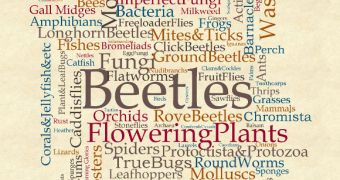According to scientists, more than 50 percent of all newly-found species are insects, which makes this class of living organisms the most unexplored on the planet. This is also highlighted in the latest issue of the International Institute for Species Exploration's (IISE) annual ‘State of Observed Species’ report.
In 2009 and 2010, biologists were able to discover as many as 19,232 new species of animals, plants, insects and microorganisms. No less than 9,738 of these species were insects, according to the 2011 State of Observed Species (SOS) report.
The IISE, which is based at the Arizona State University (ASU), released the document on January 18. Insects were followed by vascular plants, with 2,184 new species (11.3 percent) and arachnids, a class of invertebrates that includes spiders and mites, with 1,487 species.
In addition, scientists also found 41 new species of mammals and 7 species of birds. These figures raise the total number of known living species by 5.6 percent, compared to 2008 levels. The SOS report seeks to compile a comprehensive database of global flora and fauna.
As an interesting side note, experts mention the fact that the number of species discovered over the past two years is 200 percent higher than the total number of species known 250 years ago, when Swedish botanist Carolus Linnaeus developed the modern system of plant and animal names and classifications.
The announcement was made by ASU entomologist Quentin Wheeler, who is also the founding director of the IISE. “The cumulative knowledge of species since 1758 when Linnaeus was alive is nearly 2 million, but much remains to be done,” he explains.
“A reasonable guess is that 10 million additional plant and animal species await discovery by scientists and amateur species explorers,” the expert goes on to say. In modern time, a huge portion of such studies is conducted via macrogenomic surveys of DNA.
The latest investigations of this kind showcased “enormous and previously unsuspected levels of genetic diversity that corresponds in some not-yet-understood way to species diversity,” he explains.
Scientists estimate that there are 20 million species of marine microbes living in the world's oceans. An additional increase in new species is expected in beetles (order Coleoptera). This has been a trend over the past few decades, and 2009 was no different. Experts recorded 3,485 new beetle species 2 years ago.
Also interesting to note here is that 2009 revealed more extinct bird species – through tens of fossils – than living species. In total, 1,905 fossil species were discovered two years ago, of which 25.6 percent were accounted for by insects and spiders.
“As the number of species increases, so too does our understanding of the biosphere. It is through knowledge of the unique attributes of species that we illuminate the origin and evolutionary history of life on our planet,” Wheeler concludes.

 14 DAY TRIAL //
14 DAY TRIAL //